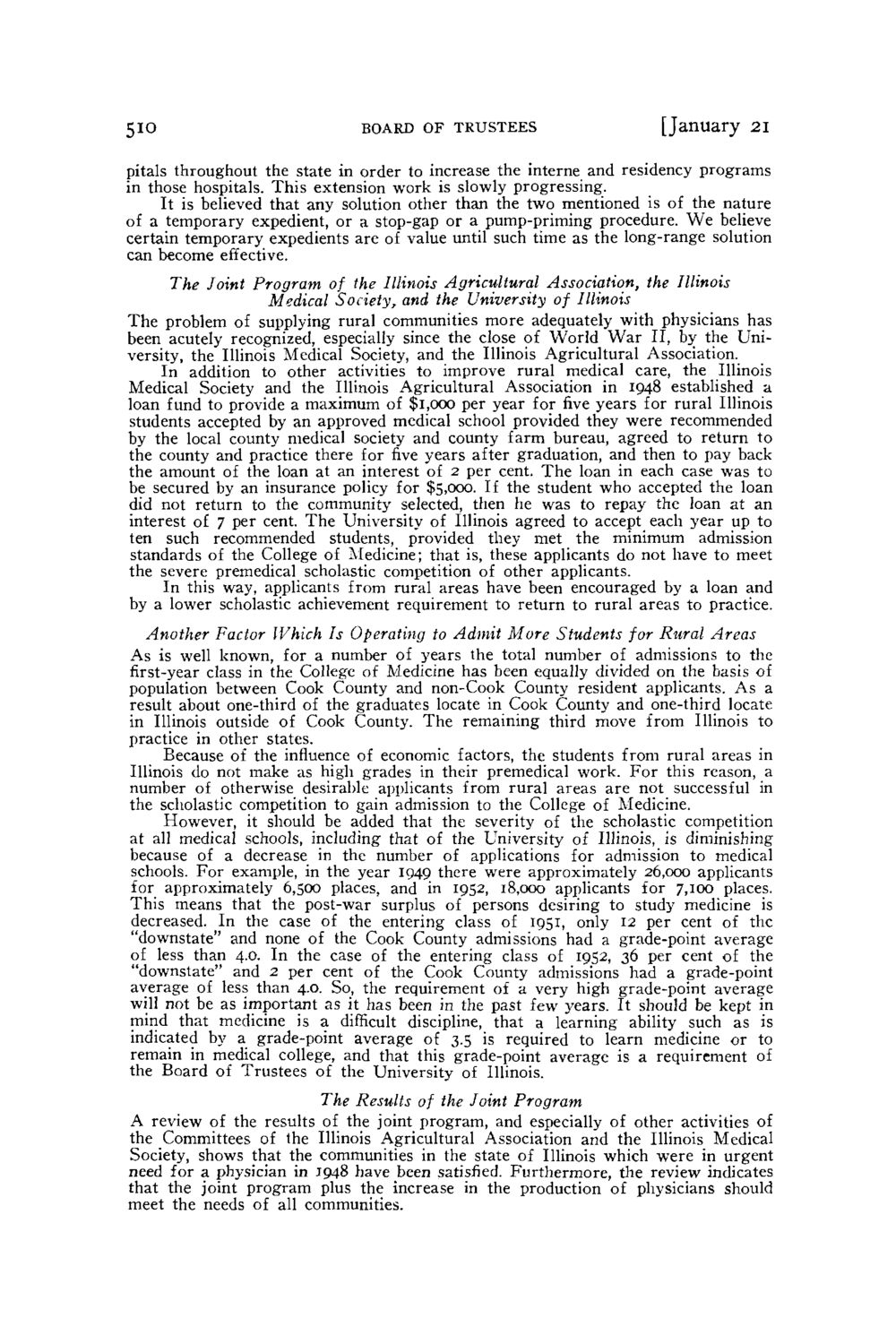| |
| |
Caption: Board of Trustees Minutes - 1954
This is a reduced-resolution page image for fast online browsing.

EXTRACTED TEXT FROM PAGE:
510 BOARD OF TRUSTEES [ J a n u a r y 21 pitals throughout the state in order to increase the interne and residency programs in those hospitals. This extension work is slowly progressing. It is believed that any solution other than the two mentioned is of the nature of a temporary expedient, or a stop-gap or a pump-priming procedure. W e believe certain temporary expedients are of value until such time as the long-range solution can become effective. The Joint Program of the Illinois Agricultural Association, the Illinois Medical Society, and the University of Illinois The problem of supplying rural communities more adequately with physicians has been acutely recognized, especially since the close of World W a r II, by the University, the Illinois Medical Society, and the Illinois Agricultural Association. In addition to other activities to improve rural medical care, the Illinois Medical Society and the Illinois Agricultural Association in 1948 established a loan fund to provide a maximum of $1,000 per year for five years for rural Illinois students accepted by an approved medical school provided they were recommended by the local county medical society and county farm bureau, agreed to return to the county and practice there for five years after graduation, and then to pay back the amount of the loan at an interest of 2 per cent. The loan in each case was to be secured by an insurance policy for $5,000. If the student who accepted the loan did not return to the community selected, then he was to repay the loan at an interest of 7 per cent. The University of Illinois agreed to accept each year up to ten such recommended students, provided they met the minimum admission standards of the College of Medicine; that is, these applicants do not have to meet the severe premedical scholastic competition of other applicants. In this way, applicants from rural areas have been encouraged by a loan and by a lower scholastic achievement requirement to return to rural areas to practice. Another Factor Which Is Operating to Admit More Students for Rural Areas As is well known, for a number of years the total number of admissions to the first-year class in the College of Medicine has been equally divided on the basis of population between Cook County and non-Cook County resident applicants. As a result about one-third of the graduates locate in Cook County and one-third locate in Illinois outside of Cook County. The remaining third move from Illinois to practice in other states. Because of the influence of economic factors, the students from rural areas in Illinois do not make as high grades in their premedical work. For this reason, a number of otherwise desirable applicants from rural areas are not successful in the scholastic competition to gain admission to the College of Medicine. However, it should be added that the severity of the scholastic competition at all medical schools, including that of the University of Illinois, is diminishing because of a decrease in the number of applications for admission to medical schools. For example, in the year IQ49 there were approximately 26,000 applicants for approximately 6,500 places, and in 1952, 18,000 applicants for 7,100 places. This means that the post-war surplus of persons desiring to study medicine is decreased. In the case of the entering class of 1951, only 12 per cent of the "downstate" and none of the Cook County admissions had a grade-point average of less than 4.0. In the case of the entering class of 1952, 36 per cent of the "downstate" and 2 per cent of the Cook County admissions had a grade-point average of less than 4.0. So, the requirement of a very high grade-point average will not be as important as it has been in the past few years. It should be kept in mind that medicine is a difficult discipline, that a learning ability such as is indicated by a grade-point average of 3.5 is required to learn medicine or to remain in medical college, and that this grade-point average is a requirement of the Board of Trustees of the University of Illinois. The Results of the Joint Program A review of the results of the joint program, and especially of other activities of the Committees of the Illinois Agricultural Association and the Illinois Medical Society, shows that the communities in the state of Illinois which were in urgent need for a physician in 1948 have been satisfied. Furthermore, the review indicates that the joint program plus the increase in the production of physicians should meet the needs of all communities.
| |